|
When Cabeza de Vaca arrived on Galveston Island in November 1528, he found himself, for the first time in his life, in the company of a band of hunters and gatherers. Most of the Indians he had encountered east of the Mississippi were chiefdom-based farmers, from whom he and his comrades had stolen corn, beans, squash, fish, and ceramic vessels for carrying water. A few may have been from fishing-oriented groups who traded extensively with the chiefdoms. While the Galveston Island survivors were certainly familiar with the taste of Indian-prepared “skate fish” (what other translators called “mullet”) from their forays along the Florida Gulf coast, this was probably their first time to dine on wild roots. At that time in history, root foods, also known as geophytes (i.e., perennial plants with underground storage organs, aka perennating tissue or overwintering buds), were staples in various parts of North America and had been so among many Texas Indians for several millennia.
By their very nature, most geophytes would have been dug in the winter, as that is when their “roots”—bulbs, corms, tubers, taproots, and rhizomes—retain maximum food value. This would also be the case with hydrophyptes and helophytes, water-born roots or perennials that bear their surviving tissue underwater. Given that root foods mentioned by Cabeza de Vaca and his fellow noblemen were dug during the winter season, it would have been difficult, in the absence of flowers and other above-ground and above-water plant parts, for the trekkers to identify the plants to species or family and, perhaps, even to make meaningful comparisons with Old World root-food plants with which they were familiar.
Given the importance of root foods on Galveston Island and elsewhere in greater South Texas, what Cabeza de Vaca reported, as ground “dug up in the way where cattle roam” (Krieger's translation) and what Martin Favata and José Fernández (1993:55) translated as “the land appeared to have been trampled by livestock” may well have represented the aftermath of successful days at the local root grounds. Domestic livestock was certainly not part of the island´s fauna in the early 1500s and the Spaniards never mentioned the presence of bison on that or any other island, as surely they would have. In light of the intensity with which root-dependent hunter-gatherers dug through root grounds elsewhere in North America, including the interior Pacific Northwest, it seems plausible that the damaged ground was the product of women´s digging sticks.
There is also another hint of nearby root grounds embedded in Cabeza de Vaca´s follow-up comment, that the emptiness of the houses his man found at the village on Galveston Island was “because the Indians had gone to the country.” Favata and Fernandez translated this passage as “for the Indians had gone into the fields” and added a footnote, citing Bandelier: “The word campo of Cabeza de Vaca´s text would not be referring in this case to cultivated fields, but to clearings or the surrounding countryside.” Insofar as Cabeza de Vaca was fully cognizant of the appearances of productive root grounds at all seasons of the year at the time he recounted these events, his use of the term campo would be entirely consistent with the presence of well-managed, dug-over root grounds ready for a fallow period. In any event, there can be little doubt that productive, well-dug, and probably fire-maintained root grounds would have been common features on the Texas´ Gulf Coastal Plain.
Fredrick W. Hodge, a well-known ethnohistorian who prepared an edited version of the narrative in 1907, was also of the opinion that Cabeza de Vaca’s usage of the word campo, which he translated as “field” was in reference to root grounds. Hodge added an informative footnote to the sentence he translated as: “He [Lope de Oviedo] went, and coming to a path, took it for a distance of half a league, and found some huts, without tenants, they having gone into the field.” The footnote reads: “As this was the root-digging season, the word campo in the original evidently refers to digging “grounds” in the shoal water, and not to “woods” as Mr. Smith interpreted it.”
The importance of root foods among the coastal groups is made clear in Oviedo´s summary of the foodways of the castaways and island Indians who survived the stomach-disease epidemic.
And because all were sick and died as the natives died, they agreed to cross to the mainland to some overflowed places and ponds [paludes] to eat oysters, which the Indians eat for three or four months of the year, without eating any other things… Another four months of the year they eat herbs from the fields and blackberries; and another two months they chew some roots. And they eat some very large spiders and lizards and snakes and mice (sometimes they have deer), and for another two months they eat fish which they kill in canoes. They also eat some other roots which are like truffles [turmas de tierra], which they get from water. Those people are very well disposed and the women work a great deal. - Oviedo (Krieger 2002:257).
The Indians lived on Galveston Island, or Isla de Malhado [Island of Misfortune] as it was called by Cabeza de Vaca, from October through February and subsisted primarily from fish and unidentified hydrophytes or water-born roots. Their catch from fish weirs diminished by the end of December but roots continued to be important through February when they began to sprout and were no longer considered edible. While we do not know for certain which helophytes (i.e., marsh plants with surviving buds in water or mud at the bottom of water) were exploited, water chinquapin (Nelumbo lutea), arrowhead root or wapato (Sagittaria spp.), and cattail (Typha spp.) have been noted as likely candidates. These plants likely grew in sufficient densities to have been used as seasonal staples as would have a number of native geophytes, including spring beauty (Claytonia virginica) and yellow star-grass (Hypoxis hirsute). Cabeza de Vaca is mute as to how the island´s root foods were cooked but, but it is likely that cooking requirements varied from root-food to root-food. Some roots were probably baked in earth ovens, while others may have been cooked directly in the coals of an open hearth.
During March and April oysters were the primary food and they were taken from those parts of the bays that were best accessed from the mainland. In May, the Indians returned to the coast where they ate “blackberries,” and presumably fished. Here too, the castaways are mute as to how these foodstuffs were prepared. Of the coastal people in general, Oviedo reported that “these people do not eat anything during the whole year but fish, and not much, and for this [reason] they suffer much less hunger than those inland (with whom they were later). Which [the fish], as other things, is often scarce, and for this reason they move about so frequently because if they do not do thus they would not have anything to eat.” This quote is a bit confusing in that it seems to relate people having “not much” to eat but at the same time they “suffer less hunger.” It seems likely that Oviedo’s intent was to comment that while fish were widely available to the coast groups there never were very many fish at any one time but, compared to the interior groups who had even fewer fish, the coastal groups had enough to eat, all and all.
Some of the groups who lived farther south along the coast went inland, to an area Krieger noted was some 30-40 miles south of San Antonio. Other writers place it about 100 miles east or southeast of San Antonio. There, they subsisted in large measure on prickly pear nopalitos (pads) and later in the early fall on the tunas (fruit). Among them were the Mariames and Yguazes, as well as the “Fig People,” a name intended to denote their dependence on the fig-like tunas. As already noted, and as described in the following section, nopalitos and green tunas were often cooked in earth ovens. Pecans were a major resource during the fall along the lower reaches of the rivers that emptied into the central portion of the Texas coast. While we are told that numerous groups traveled many miles to the most productive pecan groves, nothing in the accounts attest to whether or how nut-foods were cooked. In parts of the southeast, for example, people boiled hickory nuts to extract their calorie-rich oil.
|
| While the Galveston Island survivors were certainly familiar with the taste of Indian-prepared “skate fish,” or “mullet,” from their forays along the northern coast, this was probably their first time to dine on wild roots. |
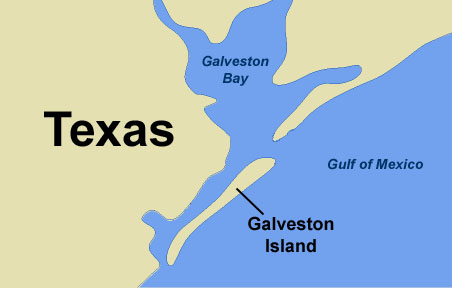
Location of Galveston Island, which the castaways referred to as "Isla del Malhado," or Island of Misfortune.  |
| Given that the root foods mentioned by Cabeza de Vaca were dug during the winter season, it would have been difficult, in the absence of flowers and other above-ground and above-water plant parts, for the trekkers to identify the plants to species or family and, perhaps, even to make meaningful comparisons with Old World root-food plants with which they were familiar. |
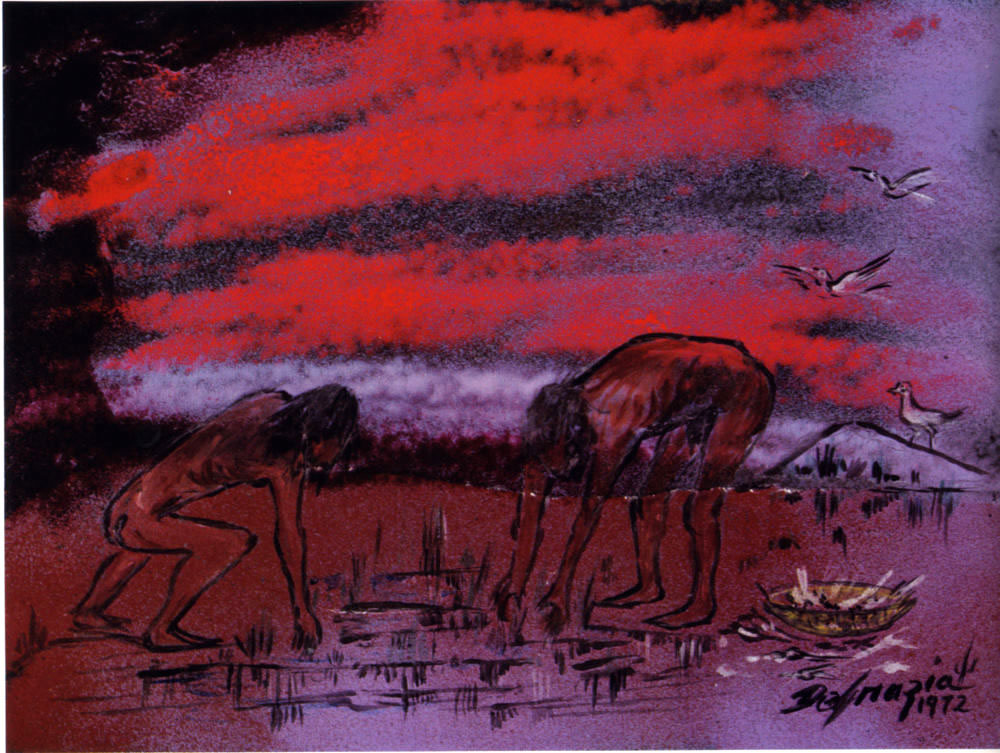
Digging for roots along the Texas coast. Cabeza de Vaca complained that this frequent, onerous task, whether grubbing in overflowed ponds or in the dirt, left his hands raw. Painting by Ted DeGrazia, courtesy of the DeGrazia Foundation.  |
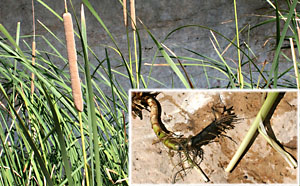
Cattail plants and rhizomes. Many parts of these plants, from pollen to tender stalks, offer nutrition. Favoring marshy banks along ponds and rivers, these helophytes may have been among the root foods sought by Cabeza de Vaca and his cohorts. Photos by Phil Dering.  |
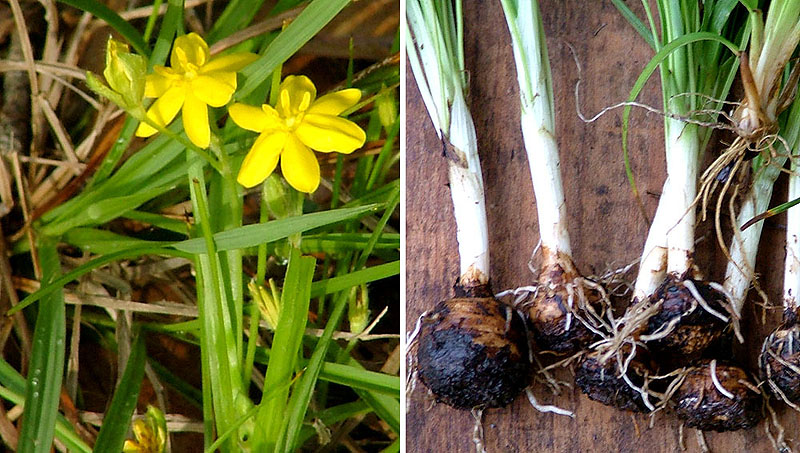
Flowers and bulbs of yellow star-grass ( Hypoxis hirsute). This native geophyte may have been dug by Cabeza de Vaca during his time in coastal south Texas.  |
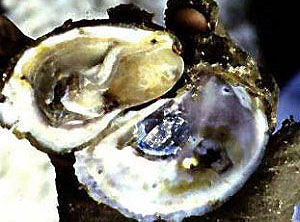
Oysters, gathered from bays and ponds, were a primary food of the coastal Indians during early spring.  |

Blackberries were a much sought after fruit during the summer.  |
|





